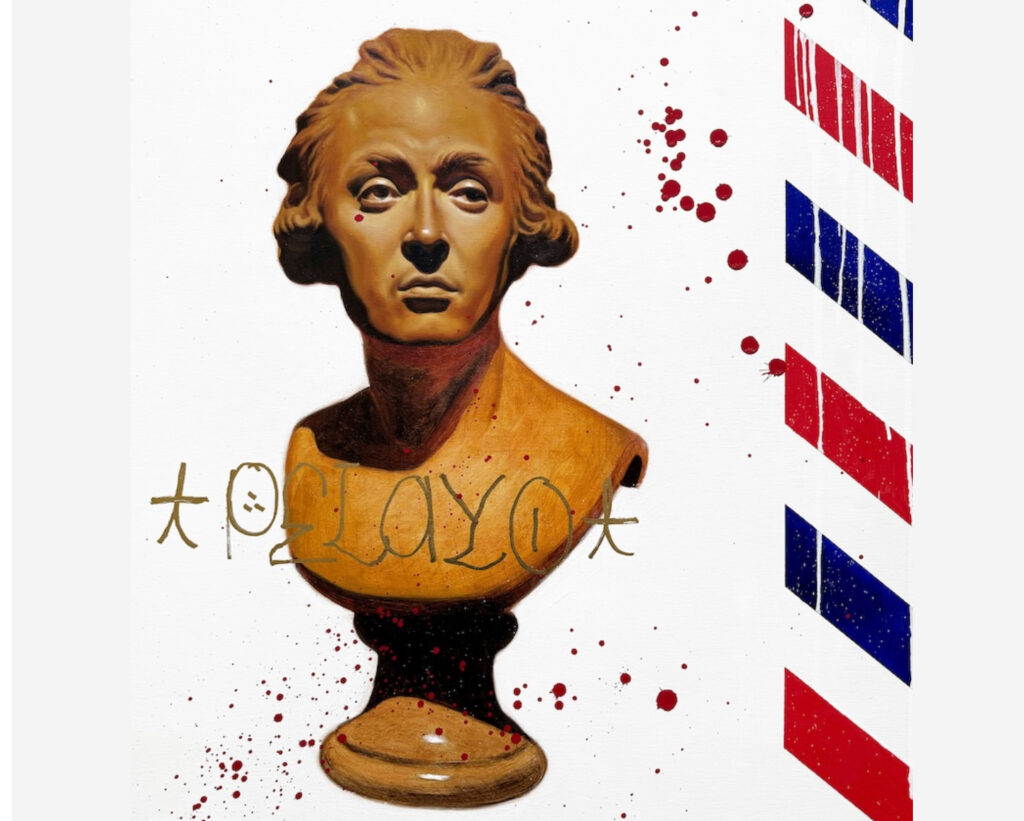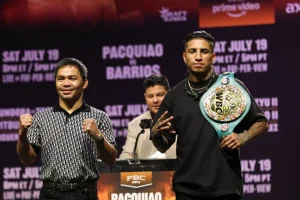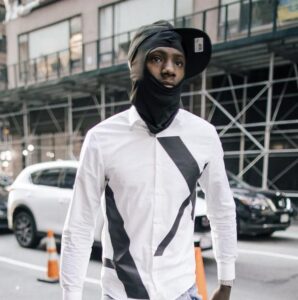


In the high desert town of Bisbee, Arizona—where craggy hills cradle a patchwork of historic buildings and the whisper of industry has long since given way to the hum of creativity—the Artemizia Foundation has once again positioned itself at the intersection of art history and cultural disruption. From April 5 to May 11, 2025, the foundation hosts Urban Renaissance, a solo exhibition by Los Angeles-based contemporary artist Isaac Pelayo.
Known for his seamless synthesis of classical European portraiture and modern urban aesthetics, Pelayo arrives in Bisbee with a mission: to redefine the boundaries of tradition, rebellion, and the role of fine art in a digital age.
A Prodigy of Dual Worlds
Born in 1996 into an artistic household—his father, Antonio Pelayo, is a respected artist and tattooer—Isaac Pelayo was immersed in visual storytelling from a young age. His technical ability became apparent early, and his visual language has matured into a compelling dialect of contradiction: the pristine detail of Renaissance masters fused with the grime and energy of Los Angeles street culture. In Urban Renaissance, Pelayo crystallizes this dichotomy, offering a body of work that is both reverent and revolutionary.
The title of the exhibition is more than thematic—it’s a manifesto. Just as the original Renaissance emerged from the intellectual and artistic ferment of 15th-century Europe, Pelayo’s work emerges from a cultural crosscurrent: the rebirth of traditional craftsmanship in an age saturated with AI-generated imagery, viral content, and cultural amnesia. His figures, painted in painstaking hyperrealism, often peer through graffiti-scrawled veils, haloed in gold, pierced by metaphor.
“I want to bridge two worlds,” Pelayo has said in past interviews. “There’s beauty in tradition, but there’s also truth in the streets. I want both.”
The Exhibition: Classical Form Meets Contemporary Fire
Urban Renaissance occupies the Artemizia Foundation’s Gallery 818, a cavernous, light-flooded space that makes use of Bisbee’s rustic architecture. The exhibition is curated as a journey through transformation, from portraits that echo Da Vinci and Caravaggio to compositions charged with the raw ethos of graffiti and tattoo culture. The show includes over 25 pieces—many never before exhibited—ranging in size from intimate studies to wall-spanning masterworks.
Upon entry, visitors are greeted by “The Martyr of Neon”, a towering oil portrait of a young man adorned in chains and streetwear, his head encircled by a gold leaf halo. Spray paint bleeds down from the top corners of the canvas, disrupting the otherwise pristine depiction. The tension is deliberate, almost confrontational. Pelayo uses classical composition not as an aesthetic endpoint, but as a rhetorical device—a Trojan horse smuggling radical intent.
Another standout is “Madonna of the Trenches”, in which a young woman—tattooed, hooded, and holding a child—is rendered with a sensitivity worthy of Raphael. Behind her, however, is a wall tagged with messages: Free Gaza, Pray for the Homeless, and Love is Revolution. The juxtaposition is jarring, but never gratuitous. Each mark, each symbol, functions like an annotation in a sacred text—angry, urgent, sacred.
An Artist in Full Control
It’s easy to mistake Pelayo’s aesthetic as trendy, perhaps because it speaks fluently in the symbols of Instagram, LA hip-hop, streetwear, and protest culture. But make no mistake: there’s nothing accidental about his style. Pelayo is a master draftsman and painter, trained in classical technique and deeply informed by art history. His reverence for the Old Masters is palpable—not only in his technique but in his themes.
Sloane Bouchever, Director of the Artemizia Foundation, emphasizes this mastery. “Pelayo’s work is a testament to the enduring power of technique and vision,” Bouchever said. “He doesn’t just appropriate old forms—he reincarnates them. Urban Renaissance speaks to his ability to merge old-world mastery with modern perspectives, making for an exhibition that is both timeless and refreshingly innovative.”
This fusion is perhaps most poignantly realized in “Pietà in the Alley”, a haunting reinterpretation of Michelangelo’s Pietà. In Pelayo’s version, the Virgin Mary is replaced by a young Latina woman in a bandana, cradling the body of a young man slain in street violence. The background is a Los Angeles alley, lit by the red-and-blue hue of police sirens. The result is devastating—and unforgettable.
The Space and Its Significance
The Artemizia Foundation, located at 818 Tombstone Canyon, is itself a symbol of reinvention. Housed in a repurposed historic building, the space is equal parts museum, gallery, sculpture garden, and cultural hub. With a permanent collection boasting names like Banksy, Swoon, de Kooning, Tracey Emin, Kara Walker, and Ai Weiwei, Artemizia has become an unlikely but vital outpost for contemporary art in the Southwest.
Hosting Urban Renaissance here is both geographically unexpected and thematically perfect. Bisbee’s own story—once a booming mining town, now a vibrant arts enclave—is echoed in Pelayo’s work, which mines the past to forge something unapologetically modern. The gallery’s labyrinthine layout and mixture of raw stone and polished surfaces offer a fitting backdrop to Pelayo’s juxtapositions.
The exhibition’s opening reception, held on April 5, drew artists, collectors, and cultural figures from across the Southwest and beyond. For many attendees, it was their first encounter with Pelayo’s work. For others, it was a moment of affirmation—that contemporary art can still stun, still provoke, and still feel vital.
Beyond the Canvas: A Cultural Reckoning
Pelayo’s art does more than dazzle; it asks questions. What does it mean to be a young artist of color navigating institutions historically dominated by European ideals? What is the role of beauty in a world riven by injustice and disinformation? How can the visual language of the past be retooled to speak to a generation raised on screens and algorithms?
In this context, Urban Renaissance becomes more than an exhibition—it becomes a cultural reckoning. By hybridizing eras and aesthetics, Pelayo calls into question the very idea of cultural hierarchy. His work posits that street art and Renaissance painting are not opposing ends of a spectrum but rather nodes in a shared human impulse: to document, to express, to survive.
In “Chicano Da Vinci”, Pelayo paints himself—a self-portrait echoing the solemnity of classical busts, but with tattoos crawling across his neck and a spray can in hand. It’s self-aware, a little cheeky, but deeply sincere. Pelayo isn’t parodying the canon; he’s claiming it.
Art in the Age of AI
One cannot consider Urban Renaissance without placing it in the context of 2025, a year in which art is increasingly shaped—and sometimes threatened—by artificial intelligence. Pelayo stands as a counterweight to that trend. His meticulous, hand-crafted works argue not against technology, but for the irreplaceable value of the human hand and eye.
“I don’t care how realistic an AI image looks,” Pelayo recently said on social media. “It’ll never have a heartbeat. My brushstrokes are my heartbeat.”
Indeed, in an era of fleeting attention and digital noise, Pelayo’s work feels radical in its insistence on presence. Each canvas invites slow looking, patient contemplation. In this way, Urban Renaissance is as much about pace as it is about aesthetics—a call to decelerate, to look closer, to remember.
A Movement in the Making?
Is Urban Renaissance the beginning of a movement? Perhaps. Though Pelayo is singular in his vision, he is not alone in his desire to reconcile tradition with disruption. Across the globe, young artists are reclaiming history, infusing classical form with contemporary urgency. What sets Pelayo apart, however, is the coherence of his vision. He is not dabbling—he is building.
There’s talk already of the exhibition traveling to other cities: Los Angeles, New York, Mexico City. Wherever it lands, it will likely provoke the same visceral reaction: awe, unease, recognition. That is the power of Pelayo’s art—it doesn’t merely depict the world; it refracts it, revealing truths that linger long after the paint has dried.
Final Impressions
As the exhibition’s end date nears, Urban Renaissance remains one of the most talked-about shows in the region. It has drawn not only traditional art audiences but also young people, educators, and activists—many of whom see in Pelayo’s work a mirror of their own struggles and dreams.
For Bisbee, the show cements its status as more than an artistic retreat. It is a place where important conversations are happening, where history is being challenged and remade. For the Artemizia Foundation, it’s another bold curatorial choice that underscores its commitment to relevancy, diversity, and excellence.
And for Isaac Pelayo, Urban Renaissance is a declaration: that the past is not behind us, but alive in the choices we make today. That beauty is not the opposite of protest, but its most enduring form. That art, at its best, does not conform—it transforms.
EXHIBITION DETAILS:
Isaac Pelayo: Urban Renaissance
Dates: April 5 – May 11, 2025
Location: Artemizia Foundation, 818 Tombstone Canyon, Bisbee, AZ
Hours: Thursday – Sunday, 11 AM – 4 PM
Admission: $10 (Free for members)
Would you like this in a downloadable PDF or formatted for a specific publication (e.g., magazine, online journal)?
No comments yet.








